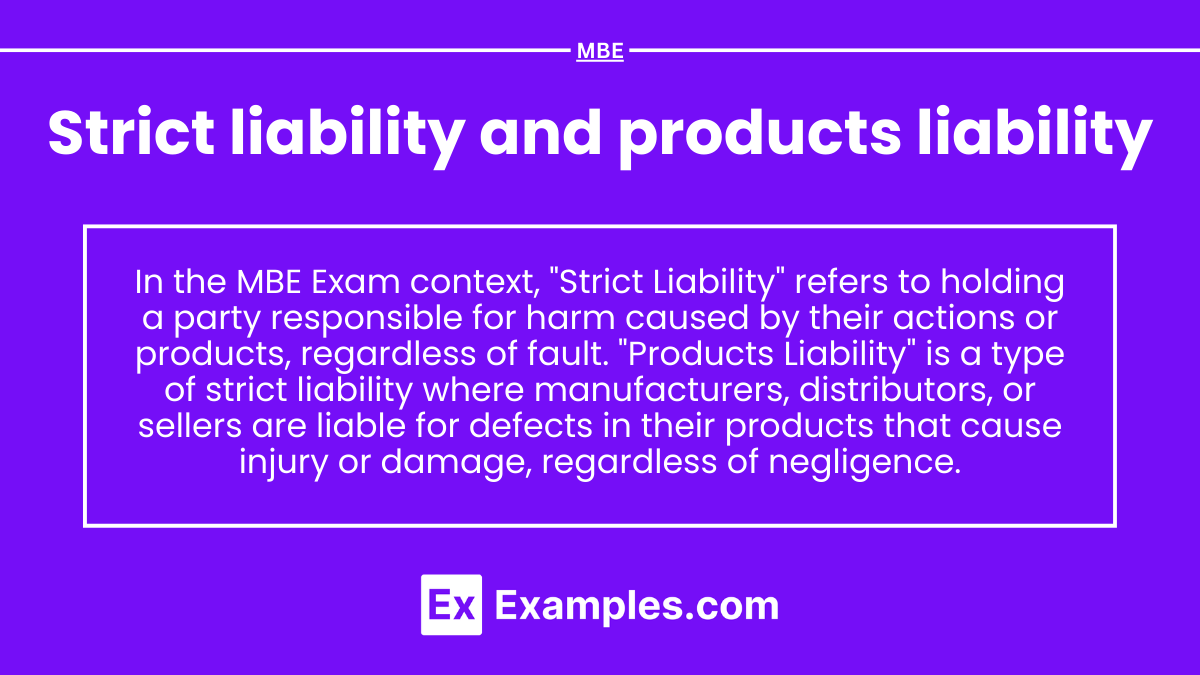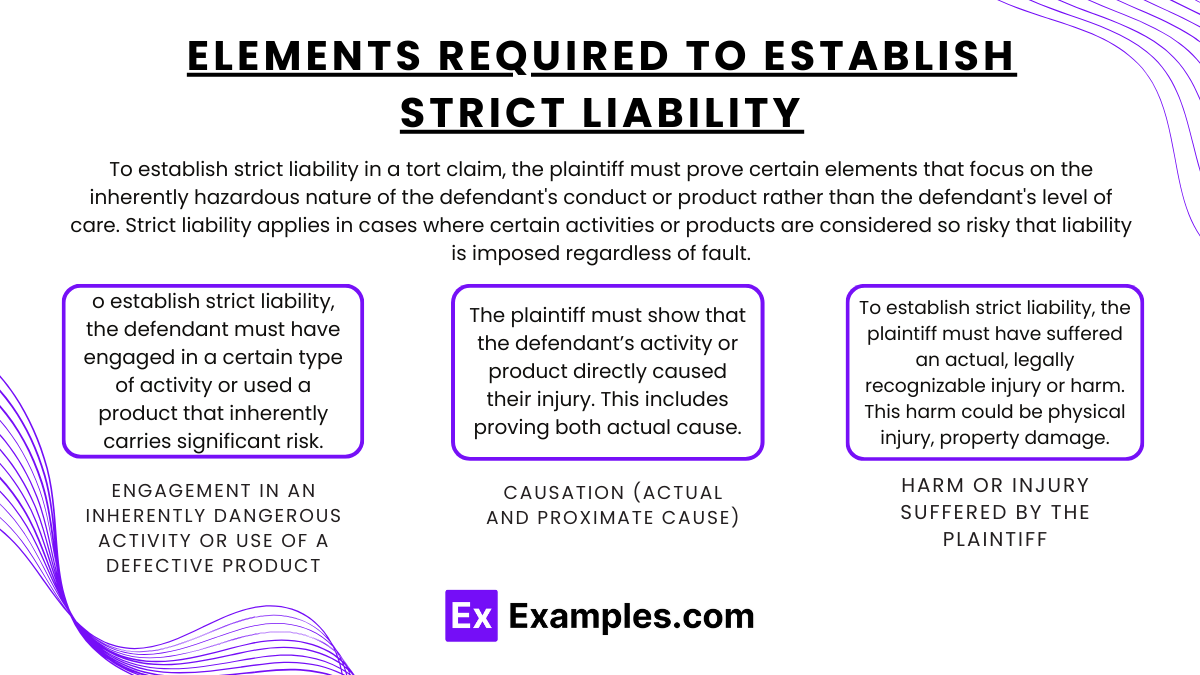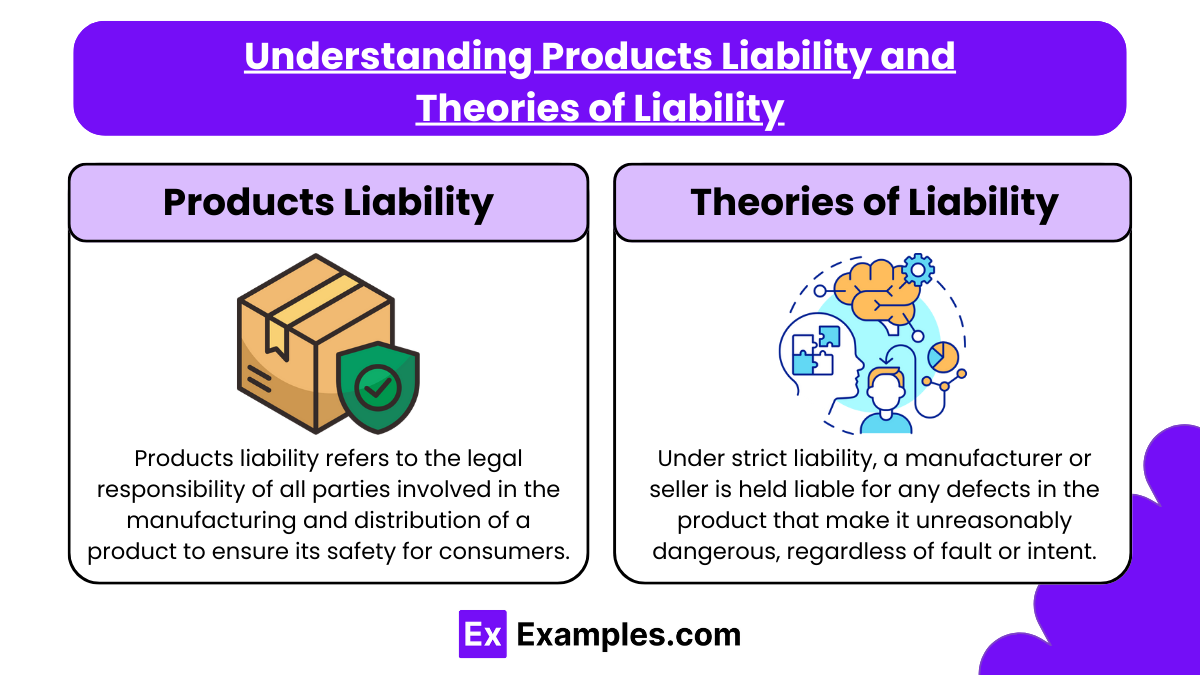Strict Liability and Products Liability address legal principles that hold parties responsible for harm caused by their actions or products, regardless of intent or negligence. This topic examines the conditions under which a party can be held strictly liable, particularly in cases involving defective products that lead to consumer injury. It covers various aspects, including the standards for defectiveness, types of product defects, and defenses available to manufacturers and sellers. Mastering these principles is essential for understanding the balance between consumer protection and business liability, providing a foundation for effective analysis in tort law.
Learning Objectives
In studying "Strict Liability and Products Liability" for the MBE, you should learn to distinguish between strict liability and negligence in tort law, focusing on scenarios where liability is imposed without fault. Understand the elements required to establish strict liability, particularly in cases involving abnormally dangerous activities and wild animals. Examine the concept of products liability, identifying the different theories under which a manufacturer or seller can be held liable, including strict liability, negligence, and breach of warranty. Analyze the requirements for proving a defect in design, manufacturing, or warning that renders a product unreasonably dangerous. Evaluate defenses available to defendants in strict and products liability cases, such as assumption of risk and contributory negligence. Additionally, apply these principles to hypothetical scenarios on the MBE to determine the appropriate legal outcomes.
Distinguishing Between Strict Liability and Negligence in Tort Law
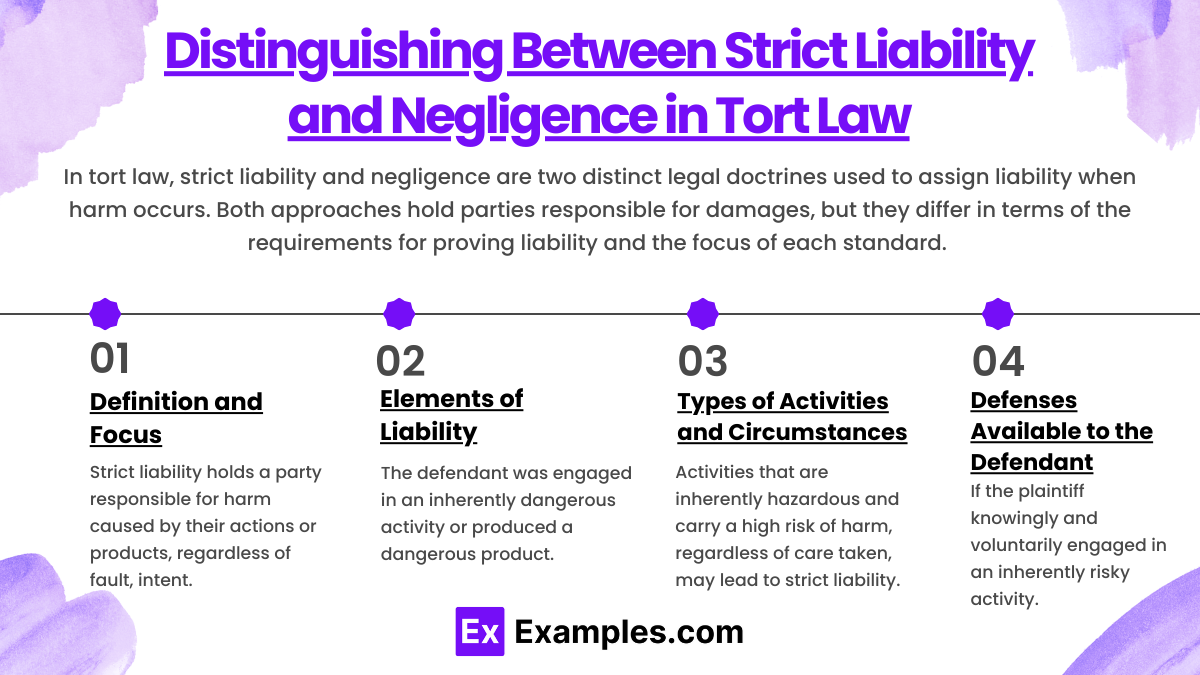
In tort law, strict liability and negligence are two distinct legal doctrines used to assign liability when harm occurs. Both approaches hold parties responsible for damages, but they differ in terms of the requirements for proving liability and the focus of each standard. Here’s a breakdown of how strict liability and negligence are distinguished:
1. Definition and Focus
Strict Liability:
Definition: Strict liability holds a party responsible for harm caused by their actions or products, regardless of fault, intent, or care taken to prevent the harm. The plaintiff does not need to prove that the defendant was negligent.
Focus: The focus in strict liability cases is on the inherently dangerous nature of the activity or product, not on the defendant’s conduct. Liability is imposed if the activity or product caused harm, regardless of the precautions taken.
Typical Cases: Strict liability is commonly applied in cases involving abnormally dangerous activities (like blasting), certain animal-related injuries, and defective products.
Negligence:
Definition: Negligence requires the plaintiff to prove that the defendant failed to exercise reasonable care, leading to harm. The plaintiff must show that the defendant had a duty of care, breached that duty, caused harm, and that the harm resulted in damages.
Focus: The focus in negligence cases is on the defendant’s conduct and whether it met the standard of care expected under the circumstances. Liability is imposed if the defendant’s actions fell below what a reasonable person would do to prevent harm.
Typical Cases: Negligence is the standard in most personal injury cases, car accidents, medical malpractice, and other situations where harm results from careless or reckless behavior.
2. Elements of Liability
Strict Liability:
Elements: Strict liability cases typically require the plaintiff to prove three elements:
The defendant was engaged in an inherently dangerous activity or produced a dangerous product.
The defendant’s activity or product caused the plaintiff’s injury.
The plaintiff suffered actual damages as a result.
No Need to Prove Fault: Under strict liability, the defendant’s level of care or intent is irrelevant. The plaintiff does not need to show that the defendant acted unreasonably, negligently, or with intent to cause harm.
Negligence:
Elements: Negligence requires four elements to be proven by the plaintiff:
Duty of Care: The defendant owed the plaintiff a duty to act as a reasonable person would under similar circumstances.
Breach of Duty: The defendant breached that duty by failing to act reasonably.
Causation: The defendant’s breach of duty was the actual and proximate cause of the plaintiff’s injury.
Damages: The plaintiff suffered actual harm or damages due to the defendant’s breach.
Need to Prove Fault: In negligence cases, proving fault is essential. The plaintiff must show that the defendant’s conduct fell below the expected standard of care and that this failure led to the plaintiff’s harm.
3. Types of Activities and Circumstances
Strict Liability:
Abnormally Dangerous Activities: Activities that are inherently hazardous and carry a high risk of harm, regardless of care taken, may lead to strict liability. Examples include handling explosives, using toxic chemicals, and keeping wild animals.
Product Liability: Manufacturers, distributors, and retailers may be held strictly liable for harm caused by defective products. This includes design defects, manufacturing defects, and failure to provide adequate warnings.
Animal Liability: Owners may be strictly liable for harm caused by certain animals, particularly wild animals or pets with known dangerous propensities.
Negligence:
Ordinary Activities with Reasonable Care Expectations: Most day-to-day activities fall under negligence law, where people are expected to exercise reasonable care. Common examples include driving a vehicle, providing medical treatment, and maintaining safe premises.
Professional and Personal Conduct: Cases involving doctors, lawyers, business owners, and other professionals are usually governed by negligence, as the primary question is whether they met the standard of care in their field.
4. Defenses Available to the Defendant
Strict Liability:
Assumption of Risk: If the plaintiff knowingly and voluntarily engaged in an inherently risky activity, they may be barred from recovery. For instance, a person who knowingly walks into a restricted area where blasting is taking place may assume the risk.
Product Misuse: In product liability cases, the defendant may argue that the plaintiff’s misuse of the product, in a way it was not intended, led to the injury.
Comparative Fault: Some jurisdictions allow for comparative fault even in strict liability cases, reducing the plaintiff’s recovery if they were partially responsible for the harm.
Negligence:
Contributory Negligence: If the plaintiff’s own negligence contributed to their injury, they may be barred from recovery (in jurisdictions that follow contributory negligence) or their recovery may be reduced.
Comparative Negligence: In comparative negligence systems, the plaintiff’s damages may be reduced in proportion to their degree of fault.
Assumption of Risk: If the plaintiff willingly engaged in a risky activity and accepted the associated dangers, the defendant may be relieved of liability.
Elements Required to Establish Strict Liability
To establish strict liability in a tort claim, the plaintiff must prove certain elements that focus on the inherently hazardous nature of the defendant's conduct or product rather than the defendant's level of care. Strict liability applies in cases where certain activities or products are considered so risky that liability is imposed regardless of fault. This type of liability is commonly associated with abnormally dangerous activities, defective products, and dangerous animals.
1. Engagement in an Inherently Dangerous Activity or Use of a Defective Product
Definition: To establish strict liability, the defendant must have engaged in a certain type of activity or used a product that inherently carries significant risk. Unlike negligence, strict liability does not consider the level of care or precautions taken. Instead, the focus is on the activity's or product's nature.
Types of Situations Subject to Strict Liability:
Abnormally Dangerous Activities: Activities that carry a high risk of serious harm even when all reasonable precautions are taken. Examples include activities like blasting, handling hazardous chemicals, or storing explosives.
Product Liability: Manufacturers, distributors, and retailers can be strictly liable if a product defect (design, manufacturing, or labeling defect) causes injury. The defect must make the product unreasonably dangerous for its intended use.
Animal Liability: Owners of certain animals, especially wild animals or domestic animals with known dangerous propensities, may be strictly liable for injuries caused by the animal. Wild animals are typically subject to strict liability because they are inherently unpredictable and pose risks to others.
Example: A company that stores toxic chemicals near residential areas could be strictly liable if an accidental leak causes harm, regardless of the safety measures the company implemented.
2. Causation (Actual and Proximate Cause)
Definition: The plaintiff must show that the defendant’s activity or product directly caused their injury. This includes proving both actual cause (the defendant’s conduct factually led to the injury) and proximate cause (the injury was a foreseeable result of the defendant’s activity).
Actual Cause: Also known as “cause-in-fact,” actual cause requires proof that the injury would not have occurred “but for” the defendant’s dangerous activity or defective product.
Proximate Cause: Proximate cause requires that the injury be a foreseeable consequence of the defendant’s conduct. If an unforeseeable, intervening event breaks the chain of causation, the defendant may not be held liable.
Example: If a defective airbag in a car causes injury during a collision, the plaintiff must show that the airbag’s defect was a direct and foreseeable cause of the injury.
3. Harm or Injury Suffered by the Plaintiff
Definition: To establish strict liability, the plaintiff must have suffered an actual, legally recognizable injury or harm. This harm could be physical injury, property damage, or, in some cases, emotional distress.
Types of Damages:
Physical Injury: Bodily harm resulting from the dangerous activity or defective product.
Property Damage: Damage to the plaintiff’s property due to the defendant’s conduct or product defect.
Economic Loss: In some cases, economic losses that stem directly from the harm may be compensable, though strict liability typically focuses on physical and property damage.
Example: A person injured by a defective product, such as an electric appliance that short-circuits and causes a fire, must show they suffered physical harm (such as burns) or property damage (such as fire damage to their home).
Understanding Products Liability and Theories of Liability
Products liability is a legal doctrine that holds manufacturers, distributors, suppliers, retailers, and other entities in the distribution chain liable for injuries caused by defective or dangerous products. The primary goal of products liability is to protect consumers by holding parties accountable when their products cause harm. In products liability cases, plaintiffs may base their claims on three main theories of liability: strict liability, negligence, and breach of warranty.
1. Products Liability
Definition: Products liability refers to the legal responsibility of all parties involved in the manufacturing and distribution of a product to ensure its safety for consumers. If a product causes harm due to a defect or dangerous condition, the injured party may pursue a products liability claim.
Parties Held Liable: Products liability extends to various entities within the product’s distribution chain, including manufacturers, wholesalers, retailers, and distributors. Each entity involved in bringing the product to market may share responsibility for ensuring its safety.
Types of Defects:
Design Defects: The product’s design is inherently unsafe, making it dangerous even when manufactured correctly. For instance, a car with a poorly designed fuel tank placement that increases the risk of explosion in a collision has a design defect.
Manufacturing Defects: The product was safely designed but became unsafe due to an error in the manufacturing process, causing a deviation from its intended design. An example is a medication batch contaminated during production.
Marketing/Labeling Defects: Also known as “failure to warn,” this defect occurs when a product lacks adequate warnings or instructions, making it dangerous to use. For example, a power tool that fails to include a warning about potential hazards may have a labeling defect.
2. Theories of Liability
A. Strict Liability
Definition: Under strict liability, a manufacturer or seller is held liable for any defects in the product that make it unreasonably dangerous, regardless of fault or intent. The plaintiff does not need to prove that the defendant acted negligently or intended to cause harm.
Elements of Strict Liability in Products Liability:
The product was defective (design, manufacturing, or marketing/labeling defect).
The defect existed when it left the defendant’s control.
The defect made the product unreasonably dangerous for its intended use or foreseeable misuse.
The defect caused the plaintiff’s injury when the product was used as intended.
Example: If a child’s toy contains small parts that detach easily, posing a choking hazard, the manufacturer may be strictly liable for injuries caused by the defective design, regardless of the care taken during production.
Advantages of Strict Liability: Strict liability provides a strong basis for recovery since plaintiffs do not have to prove that the defendant was negligent. This shifts the focus to the product itself and whether it was unreasonably dangerous when used as intended.
B. Negligence
Definition: Negligence in products liability cases involves a failure by the defendant to exercise reasonable care in the product’s design, manufacturing, or marketing, leading to an unsafe product that causes harm.
Elements of Negligence:
Duty of Care: The defendant owed a duty to design, manufacture, or market a safe product.
Breach of Duty: The defendant breached that duty by failing to take reasonable care in design, manufacturing, or providing adequate warnings.
Causation: The breach of duty directly caused the plaintiff’s injury.
Damages: The plaintiff suffered actual harm or injury as a result.
Example: A manufacturer that fails to test a product for foreseeable risks, such as fire hazards, may be liable for negligence if the product catches fire during normal use and injures the consumer.
Challenges in Proving Negligence: Unlike strict liability, negligence requires proof of fault. Plaintiffs must show that the defendant’s conduct fell below the expected standard of care, which can be challenging, especially if the product met industry standards.
C. Breach of Warranty
Definition: A warranty is a promise or guarantee regarding the quality, safety, or performance of a product. Breach of warranty occurs when a product fails to meet the terms of an express or implied warranty, resulting in harm to the consumer.
Types of Warranties:
Express Warranty: An explicit assurance by the seller about the product’s quality, safety, or performance. This could be a written statement, advertisement, or verbal representation.
Implied Warranty of Merchantability: An implicit guarantee that a product is fit for ordinary use. For instance, a household appliance sold in stores should be fit for typical household use without causing harm.
Implied Warranty of Fitness for a Particular Purpose: If a buyer relies on the seller’s expertise to select a product for a specific purpose, an implied warranty exists that the product is suitable for that purpose.
Example: A consumer purchases a blender advertised as capable of crushing ice, but it breaks when used for this purpose, causing injury. The manufacturer may be liable for breach of express warranty if the blender fails to perform as promised.
Proof of Breach of Warranty: Plaintiffs must demonstrate that a warranty existed, the warranty was breached, and the breach caused harm. Warranties are often easier to prove than negligence, as the claim relies on showing a failure to fulfill the product’s assurances.
Proving a Defect in Design, Manufacturing, or Warning
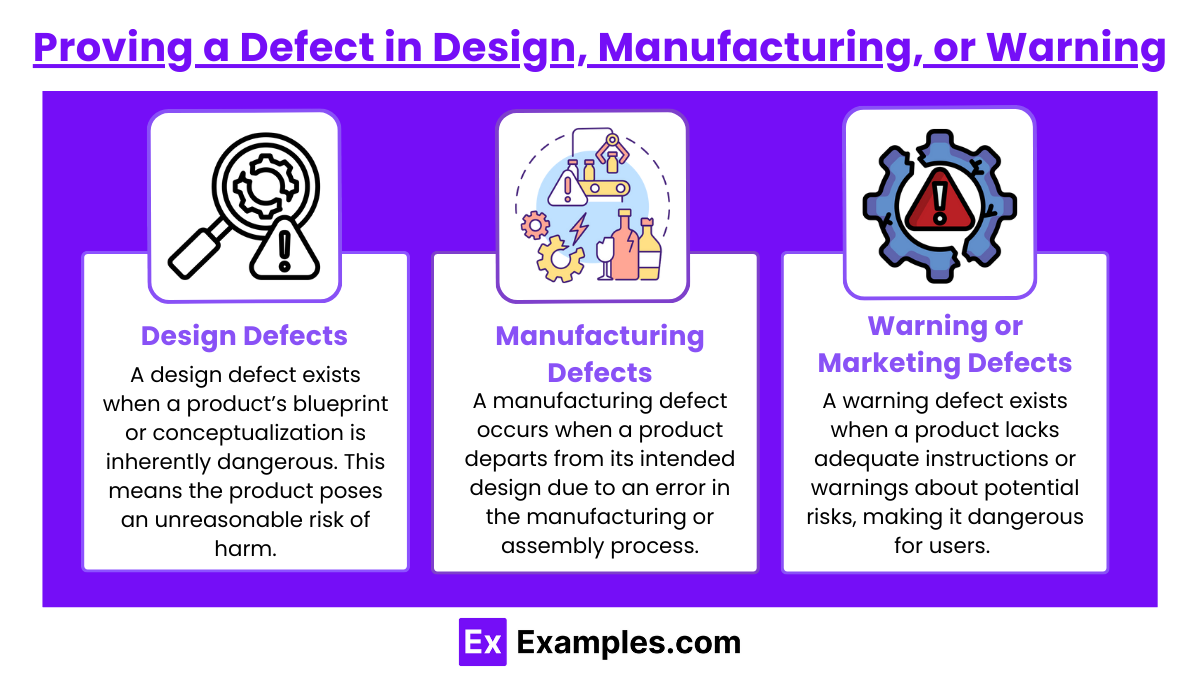
Proving a defect in a products liability case requires the plaintiff to demonstrate that the product was defective in design, manufacturing, or warning/marketing and that this defect made the product unreasonably dangerous, resulting in injury. Here’s how each type of defect is established and the key considerations involved:
1. Design Defects
Definition: A design defect exists when a product’s blueprint or conceptualization is inherently dangerous. This means the product poses an unreasonable risk of harm even if manufactured correctly and used as intended. In other words, the problem lies with the design itself rather than how it was built or marketed.
Proving a Design Defect:
Consumer Expectation Test: Under this test, the plaintiff must show that the product failed to perform safely as an ordinary consumer would expect when used in an intended or foreseeable way. If the product’s risks exceed what a reasonable consumer would anticipate, it may be considered defective.
Risk-Utility Test: Courts often use the risk-utility test, which examines whether the risks of the design outweigh its utility or benefits. Factors considered include the likelihood and severity of harm, feasibility of an alternative safer design, and the cost of implementing that design.
Feasible Alternative Design: Many jurisdictions require the plaintiff to demonstrate that a safer, practical alternative design existed at the time of production. This alternative design should reduce or eliminate the risk without significantly impacting the product’s functionality or cost.
Example: A vehicle with a poorly placed fuel tank may have a design defect if the tank’s position increases the likelihood of explosion in a rear-end collision. If it can be shown that a safer design, such as moving the tank to a safer location, was feasible, this would support a design defect claim.
2. Manufacturing Defects
Definition: A manufacturing defect occurs when a product departs from its intended design due to an error in the manufacturing or assembly process, making it unreasonably dangerous. This defect is not present in every product of the same model but only in the specific unit(s) affected by the flaw.
Proving a Manufacturing Defect:
Deviation from Design Specifications: The plaintiff must show that the product did not conform to its intended design, making it more dangerous than other products of the same type. This may involve comparing the defective product with similar products from the same batch or model.
Defective Condition: The plaintiff must demonstrate that the product was defective when it left the manufacturer’s control. If the defect arose after the product left the manufacturer, such as during transport or storage, the manufacturer might not be liable.
Expert Analysis: Proving a manufacturing defect often requires expert analysis, as the defect may involve technical or hidden issues. For example, an expert might test the product’s materials or components to show how it deviated from design specifications.
Example: If a batch of medication is contaminated during production due to improper sterilization, causing harm to consumers, this would be a manufacturing defect. The plaintiff would need to prove that the contamination occurred during manufacturing and that the medication did not match the intended, safe design.
3. Warning or Marketing Defects
Definition: A warning defect exists when a product lacks adequate instructions or warnings about potential risks, making it dangerous for users. This defect arises not from the design or manufacturing process but from the absence of information that would help consumers use the product safely.
Proving a Warning Defect:
Inadequate or Missing Warnings: The plaintiff must show that the product did not include warnings about foreseeable risks associated with its use. This includes risks that are not obvious to the average consumer but could cause harm if the product is used incorrectly or under certain conditions.
Foreseeable Misuse: A manufacturer is generally required to warn against not only the product’s intended use but also reasonably foreseeable misuses. If the product’s misuse is predictable and could lead to injury, an adequate warning is required.
Clear and Effective Warnings: The warnings provided should be clear, visible, and understandable. Courts assess whether the average user would have recognized and heeded the warning if it had been properly provided.
Example: A power saw sold without a warning about the risk of kickback may have a warning defect. If a consumer is injured by a foreseeable kickback and the injury could have been prevented with an adequate warning, the manufacturer could be held liable for failing to warn.
Examples
Example 1: Defective Pharmaceuticals
If a pharmaceutical company manufactures a drug that causes harm to a consumer due to a defect in the product—such as incorrect ingredients or inadequate labeling—the company can be held strictly liable. In product liability cases, the manufacturer is responsible for any injuries caused, regardless of whether the company was negligent in the production process.
Example 2: Dangerous Toys
A toy manufacturer can be held strictly liable if a product defect, such as small, detachable parts that pose a choking hazard, injures a child. Even if the manufacturer was careful in the production and quality control processes, they can still be held accountable for harm caused by a defect in the design or manufacturing of the toy under product liability laws.
Example 3: Automobile Recalls
When a car manufacturer produces a vehicle with a defective airbag or faulty brakes, leading to accidents or injuries, the manufacturer can be held strictly liable for the harm caused. Product liability laws protect consumers from dangerous products, and even if the defect was not intentional, the manufacturer is still responsible for repairing or compensating for damages caused by the defect.
Example 4: Contaminated Food Products
A food company that sells contaminated food that causes illness or injury can be held strictly liable. For instance, if a batch of packaged food contains harmful bacteria that leads to food poisoning, the company can be sued for product liability, regardless of whether they were negligent in their handling or processing procedures.
Example 5: Defective Construction Materials
A company that manufactures building materials, such as faulty cement or defective wiring, may be held strictly liable if those products cause damage or injury during construction. If the materials are found to be defective and cause structural failures or accidents, the manufacturer could be held accountable under product liability laws for any resulting harm, even without proving negligence.
Practice Questions
Question 1
What is the primary basis for holding a company strictly liable in a products liability case?
A) The company acted negligently.
B) The company intended to cause harm.
C) The product was defective and caused injury.
D) The consumer misused the product.
Correct Answer: C) The product was defective and caused injury.
Explanation: In a strict liability products liability case, a company can be held responsible if a defective product causes injury, regardless of whether the company was negligent or intended harm. Strict liability focuses on the product's safety and the harm it caused, rather than on the manufacturer’s intent or care during production. This principle is designed to protect consumers from unsafe products.
Question 2
Which of the following is a common defense for a manufacturer in a strict liability case?
A) The product was properly labeled.
B) The consumer misused the product in an unforeseeable way.
C) The product was expensive to produce.
D) The product was heavily marketed.
Correct Answer: B) The consumer misused the product in an unforeseeable way.
Explanation: In a strict liability case, a common defense for the manufacturer is to show that the consumer misused the product in a way that was unforeseeable. If the misuse was not expected or reasonably anticipated, the manufacturer may argue that they are not liable for resulting harm. Proper labeling, production costs, and marketing are generally irrelevant to strict liability defense.
Question 3
Under strict liability, who among the following parties can be held liable for injuries caused by a defective product?
A) Only the manufacturer
B) Only the retailer
C) Only the distributor
D) Any party in the chain of distribution
Correct Answer: D) Any party in the chain of distribution.
Explanation: Under strict liability, any party involved in the product’s chain of distribution—such as the manufacturer, distributor, or retailer—can be held liable if a defective product causes injury. This rule ensures that consumers have multiple avenues to seek compensation, even if the direct cause of the defect is unclear. This broad liability helps protect consumers by holding each party accountable for product safety.

